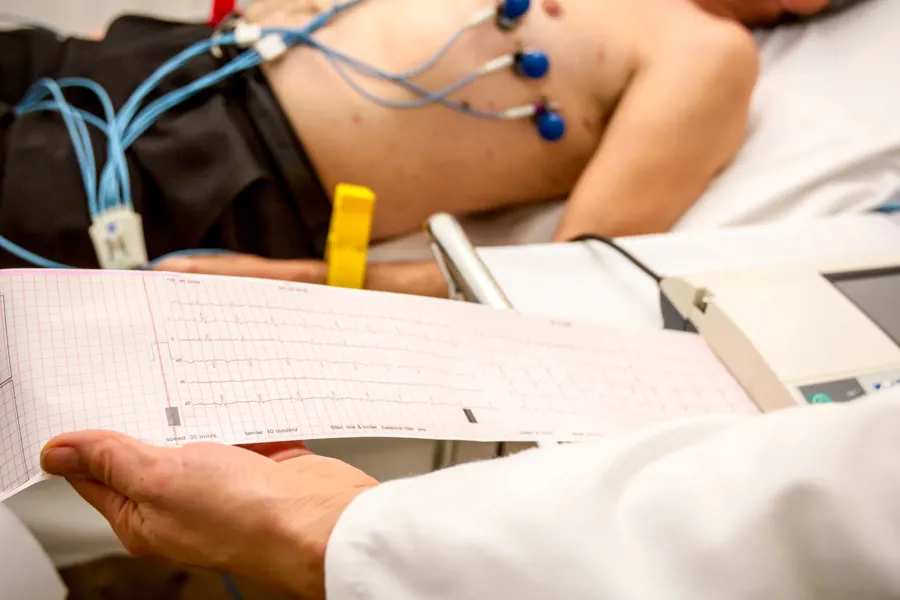Disease progression rate is a strong predictor of ventricular arrhythmias in patients with cardiac laminopathies: a primary prevention cohort study
Cardiac laminopathies are highly malignant and arrhythmogenic variants of familial dilated cardiomyopathy, with a lifetime penetrance of nearly 100%. The LMNA gene encode nuclear envelope proteins lamin A and C. LMNA mutations cause a variety of phenotypes, including cardiac and skeletal muscle disease. Ventricular arrhythmias (VAs) are common, and implantation of an implantable cardioverter defibrillator (ICD) is most often necessary. However, ICD implantation at young age may result in long-term complications, highlighting the importance of correct timing to avoid premature implantation of device. This study is the first to report disease progression rate as a predictor for ventricular arrhythmia. Some LMNA genotype–positive patients illustrated rapid disease progression prior to first ventricular arrhythmia but had not developed other classical risk predictors at time of the arrhythmic event.

Clinical implications
- The present study adds to current knowledge on risk prediction in cardiac laminopathies by describing disease progression rate by ECG and echocardiography as strong predictors of VA, and by proposing threshold values indicating transition to a more arrhythmic phase of the disease (LVEF <44%, GLS worse than −12.2%, LVEDVi >77 mL/m2, LAVi >63 mL/m2, RVD >42 mm, TAPSE <21 mm, PR interval >280 ms, QRS width >108 ms).
- Our results support that the LMNA cardiac phenotype requires close follow up. Patients’ LVEF showed a mean yearly decline of 1% and a maximum decline of 16%, suggesting that yearly echocardiographic examinations are appropriate. A decline in LVEF of ∼10% implied high arrhythmic risk and should alert the clinician also when not reaching <45%. Importantly, the clinician needs to be aware of the values from the previous visits to recognize changes in structural or functional parameters. Ideally, re-visits should be performed in the same centre by the same team. In case of new onset symptoms, or signs of electrical, structural, or functional disease progression, follow-up intervals should be increased to every 6 months, or more frequently as appropriate.
Incidence of first VA in this primary prevention LMNA cohort was 20% during almost 5 years of follow up and happened at median age of 47 years. At time of first VA, most patients showed pronounced LV structural and functional pathology, and prominent conduction delay, while RV function was preserved in most patients. However, three patients experienced VA without any classical risk markers.
We present threshold values for entering a more arrhythmic phenotype that may help alert clinicians to consider a primary preventive ICD. PR prolongation and ventricular dysfunction progressed rapidly prior to the first VA, and the individual patient disease progression rate was a strong predictor of first-time VA. Our findings support the need of individualized follow up in LMNA genotype–positive patients and dynamic evaluation of patient risk to optimize timing of implantation of a primary preventive ICD.
Risk prediction in patients with cardiac laminopathies has been elaborated in recent years, including a large multicentre study providing robust data. Still, the optimal timing of primary preventive ICD implantation remains a challenge in cardiac laminopathies. Patients are followed at regular intervals, but the time of transition to higher risk of VA is unclear and may be missed. By analysing a large number of individual-level repeated ECG registrations and echocardiographic examinations, we could evaluate patient’s disease progression which added important information on arrhythmic risk. Accelerated electrical, structural, and functional disease progressions were clear markers of higher risk of VA. Importantly, 2 of 3 patients without any of the classical risk markers at time of VA showed >10% decline in LVEF prior to the event without reaching LVEF <45%, indicating that progression per se should be noted as increased arrhythmic risk, particularly when LVEF is above 45% and traditional risk markers are not fulfilled. Importantly, disease progression remained a strong predictor of VA after adjusting for the traditional risk markers NSVT, high-degree AV block, and LVEF <45%.
Disease progression rate is a strong predictor of ventricular arrhythmias in patients with cardiac laminopathies: a primary prevention cohort study | EP Europace | Oxford Academic (oup.com)
Europace. 2022 Nov 10;euac192.
Christine Rootwelt-Norberg, Eystein T Skjølsvik, Monica Chivulescu, Martin P Bogsrud, Margareth P Ribe, Eivind W Aabel, Jan Otto Beitnes, Pål H Brekke, Trine F Håland, Nina E Hasselberg, Øyvind H Lie, Kristina H Haugaa
PMID: 36352512
DOI: 10.1093/europace/euac192
Shared under Creative Commons (CC-BY-NC) license.
The study was also presented at EACVI congress in December 2021 where Rootwelt-Norberg was awarded the Young Investigator Award in clinical science, and at the EHRA congress in April 2022.

Christine Rootwelt-Norberg, copyright Åsne Rambøl Hillestad, UiO